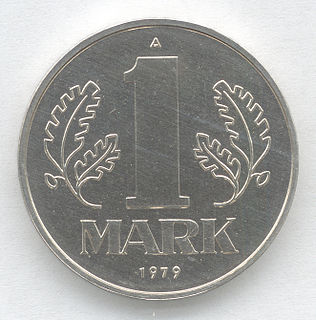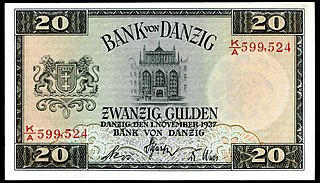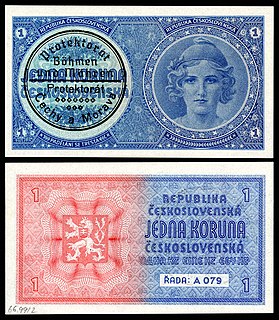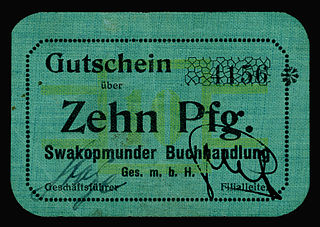
The East German mark, commonly called the eastern mark(Ostmark in West Germany and after the reunification), in East Germany only Mark, was the currency of the German Democratic Republic. Its ISO 4217 currency code was DDM. The currency was known officially as the Deutsche Mark from 1948 to 1964, Mark der Deutschen Notenbank from 1964 to 1967, and from 1968 to 1990 as the Mark der DDR. It was divided into 100 Pfennig (Pf).

The rupee is the currency of Sri Lanka, divided into 100 cents. It is issued by the Central Bank of Sri Lanka. The abbreviation is generally Rs., but "LKR" is occasionally used to distinguish it from other currencies also called rupee.

The Papiermark was the German currency from 4 August 1914 when the link between the Goldmark and gold was abandoned, due to the outbreak of World War I. In particular, Papiermarks were the banknotes issued during the hyperinflation in Germany of 1922 and especially 1923.

The Krone or korona was the official currency of the Austro-Hungarian Empire from 1892 until the dissolution of the empire in 1918. The subunit was one hundredth of the main unit, and was called a Heller in the Austrian and a fillér in the Hungarian part of the Empire.

Goldmark was the gold standard-based currency of the German Empire from 1873 to 1914. Papiermark was the much-devaluated Mark after the gold standard was given up in August 1914, and gold and silver coins ceased to circulate.

The dollar has been the currency of Liberia since 1943. It was also the country's currency between 1847 and 1907. It is normally abbreviated with the sign $, or alternatively L$ or LD$ to distinguish it from other dollar-denominated currencies. It is divided into 100 cents.

The rigsdaler was the name of several currencies used in Denmark until 1875. The similarly named Reichsthaler, riksdaler and rijksdaalder were used in Germany and Austria-Hungary, Sweden and the Netherlands, respectively. These currencies were often anglicized as rix-dollar or rixdollar.

The real was the unit of currency of Portugal from around 1430 until 1911. It replaced the dinheiro at the rate of 1 real = 840 dinheiros and was itself replaced by the escudo at a rate of 1 escudo = 1000 réis. The escudo was further replaced by the euro at a rate of 1 euro = 200.482 escudos in 2002.

The Rupie was the currency of German East Africa between 1890 and 1916, continuing to circulate in the Tanganyika Territory until 1920.

The Gulden was the currency of the Free City of Danzig between 1923 and 1939. It was divided into 100 Pfennige.

The Bohemian and Moravian koruna, known as the Protectorate crown, was the currency of the Protectorate of Bohemia and Moravia between 1939 and 1945. It was subdivided into 100 haléřů.
The peso was the currency of El Salvador between 1877 and 1919.
The Mark was the currency of German South West Africa between 1885 and 1915. Until 1914, the German Mark circulated. Within days of the outbreak of the First World War, an issue of paper money titled Deutsch-Südwestafrikanische Mark was authorized in denominations of 5, 10, 20, 50 and 100 Marks.

The Mark was the currency of the colony of German New Guinea between 1884 and 1911. It was equal to the German Mark, which was also legal tender in the colony.

The krone was a short-lived, provisional currency used in parts of the then newly formed Kingdom of Serbs, Croats, and Slovenes, parts of which had previously been part of the Austro-Hungarian Empire (Austria-Hungary).
The franc is the currency of New Caledonia and Wallis and Futuna. It is subdivided into 100 centimes. Since 1945, it has been part of the CFP franc.
The franc is the currency of French Polynesia. It is subdivided into 100 centimes. Since 1945, it has been part of the CFP franc.

The South West African mark was a temporary currency issued between 1916 after the withdrawal of the German South-West African mark, and prior to the introduction of the South African pound in 1918.
Banknotes were issued by Volkskas Limited between 1949 and 1959 from its Windhoek branch. The notes are quite scarce.

The Japanese government-issued rupee in Burma was a Japanese invasion money issued by the Japanese Military Authority, as a replacement for local currency during the Japanese occupation of Burma in the Second World War.

















